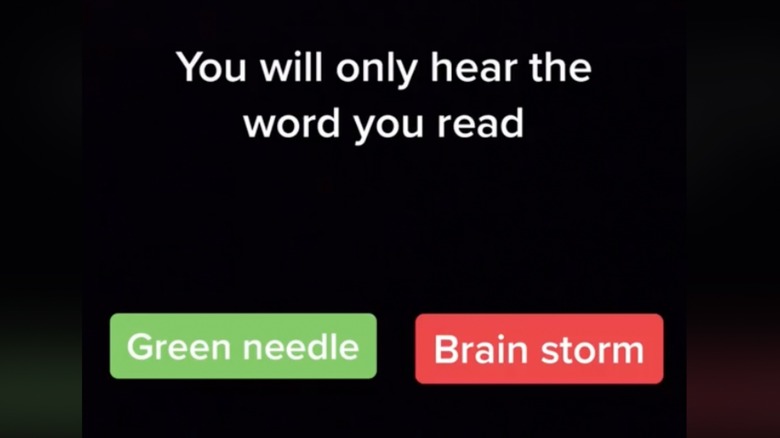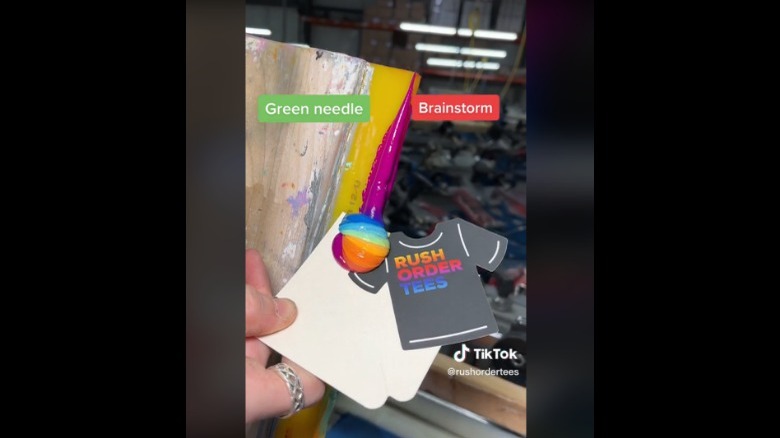The McGurk Effect: The Mind-Bending Audio Illusion Taking TikTok By Storm
As the old saying goes, "seeing is believing," which means simply, sight and our other senses are the only things we can trust to interact with and accurately interpret the outside world. However, the more science learns about the relationship between how our minds work when they receive input from our bodies the less reliable that proverb seems. Should our sensory input channels get crossed for whatever reason, what we see and hear can be far removed from reality. And that's as true for our eyes as it is for our ears, as the McGurk Effect illustrates, according to Frontiers in Psychology from the National Library of Medicine.
Examples of the McGurk Effect illusion at work have gone viral several times on the internet, as viewers are urged to test their ears and eyes in certain video clips. Remember the Yanny vs. Laurel trend, in which listeners were divided on whether or not they heard the word "Yanny" or "Laurel?" The real word was "Laurel," according to TIME Magazine. Still, hundreds of thousands who encountered the clip online swore they heard "Yanny," or that what they heard changed upon repeated listening. The McGurk Effect showed up again on TikTok a few years later, when the word "brainstorm" got compared to the words "green needle" while those words appeared on the screen over the same low-quality audio (via The U.S. Sun).
You will only hear the word you are reading
As mentioned in any one of the TikTok clips demonstrating the "brainstorm" and "green needle" McGurk Effect, viewers will only hear the word they are reading on the screen, as the text or voiceover points out. Focus on "green needle" as it appears on the screen, and chances are, you'll also hear "green needle," and vice versa with "brainstorm," two words that both visually and audibly are clearly not the same. So what's going on here? As mentioned, the so-called McGurk Effect, sometimes called the McGurk-MacDonald Effect, was first studied in the mid-1970s (via ScienceDirect). What researchers found is that our five senses, but especially hearing and sight, work in concert with one another more than expected.
Central to the McGurk Effect phenomena is that when we see someone say a phoneme — a basic element of language such as "ga," think something like baby talk — but we hear someone say "ba," we hear a third phoneme like "da," string those all together and we have words. In short, the visual and auditory signals get confused, suggesting the integrated role both sight and sound have in what we see and hear. The McGurk Effect plays a part in how we lip read and also explains why we tend toward the aforementioned "baby talk" with young children across cultures. Those just learning to speak rely just as much on what they see with their eyes to extrapolate meaning — a caretaker's over-exaggerated happy expression, for example — than they take in with their ears.
Low quality audio can also make the McGurk Effect happen
But wait, you might be asking, after watching any one of the "brainstorm or green needle" McGurk Effect TikTok videos, there are no lips moving at all. Instead, we hear the sound — albeit low quality — as the words appear on the screen. Therein lies the magic. Our eyes are still taking in information, like infants examining the face of a parent — but our ears can't quite make out the word. As a result, our brains fill in the rest. Speaking with The U.S. Sun, audiologist, Katie Ogden, explained, though baffling that sets of different words seem to shapeshift into one another, it all has to do with the way our brains process input.
As our minds receive the sound, they turn incomplete information into something whole and meaningful, "which is why you hear something very specific and defined each time the audio plays," Ogden said. "Your brain is being primed to expect a certain acoustic pattern based on which word you happen to be looking at and digesting," the audio. "Examples like this viral sensation help to further prove the incredible wonders regarding the sense of hearing and its connection to the brain," Ogden added. Speaking with The Telegraph in 2018, professor of speech sciences at University College London, Valerie Hazan, said, as our brains are primed to expect acoustic patterns that match expected word patterns, if signals are at all ambiguous, our brain simply attempts the best fit.
Audio frequency also plays a part
As The Telegraph went on to report in 2018, the "brainstorm/green needle" audio-optical illusion was first noticed by a toy collector. The toy in question is supposed to say "brainstorm," the character's name on the American show, "Ben 10 Alien Force." Among the first to notice the mix-up was YouTube vlogger DosmRider, and it was pointed out on Twitter by @mitchellmoffit that same year. "WHAT IS HAPPENING IN THE WORLD, WHY IS EVERYTHING I HEAR FAKE NOW [sic] ... You can hear the words "Green Needle" or "Brainstorm" based on which one you THINK about [sic]," Moffit's tweet read.
The video clip @mitchellmoffit and others shared has no words at all, proving just how powerful the McGurk Effect can be. Explaining how that might happen purely on audio input, speech professor Valeri Hazan added: "If our brains expect patterns for green needle, then it will track the patterns in the signal which have more energy in higher frequencies as these are more consistent with some patterns in the sounds in green needle. If it expects brainstorm, it will track the lower-frequency patterns which are more consistent with those you would find in a clearer production of Brainstorm." Or as @MrsMamaJay put it, replying to @mitchellmoffit, on Twitter: "Literally tho I can swap them out thinking of each word [sic]. Oh psychology. "



